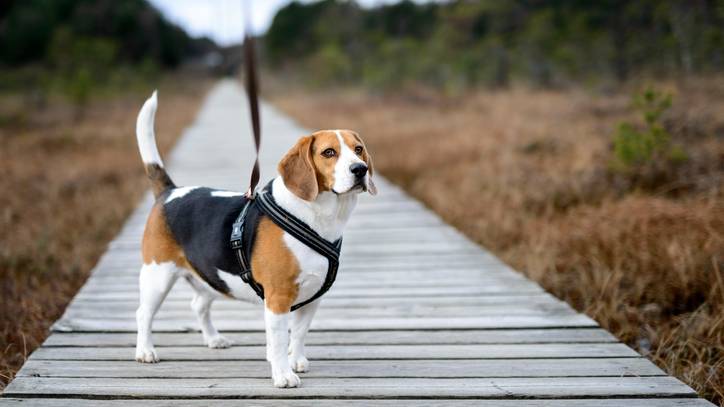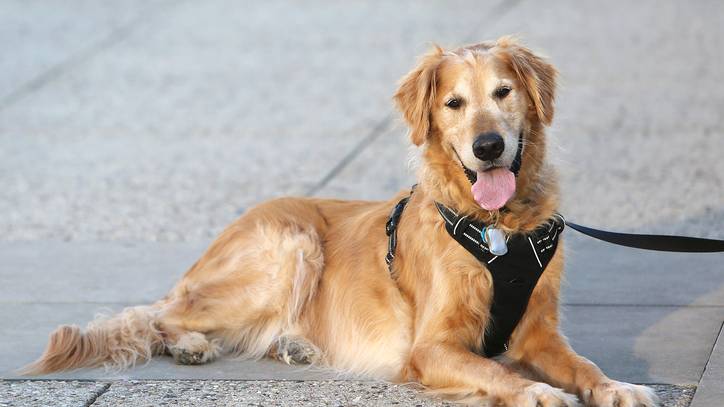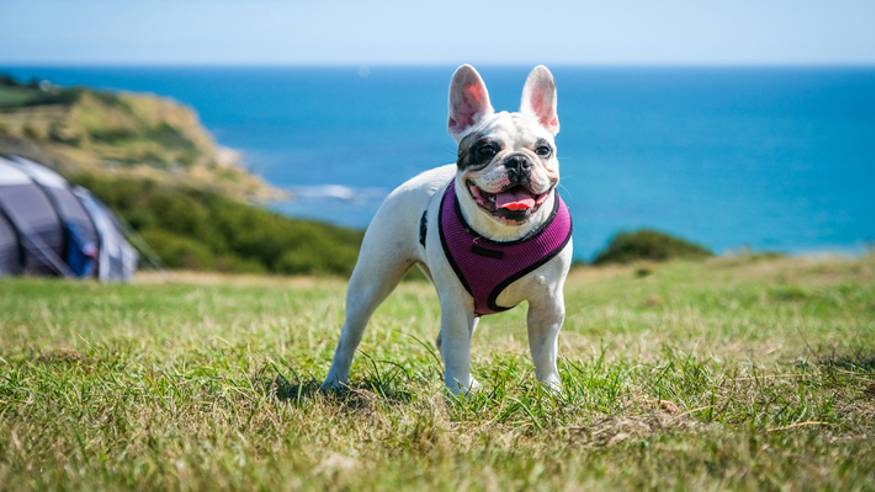Is it safe to leave a harness on a dog all the time?
Is it safe to leave a harness on a dog all the time? Our vet weighs in…

Is it safe to leave a harness on a dog all the time? It’s a question you may have found yourself asking if you’re in the throes of training and are wanting to help your pup become familiar with their new getup so that they’re more comfortable and obedient when it’s time to go on the leash.
Alongside being designed to create less pull on the neck when being on a leash and to distribute the weight of the pull more evenly around a dog's chest and shoulders, the best dog harnesses can be a useful aid when it comes to reducing anxiety in dogs while also keeping them safe when out and about.
However, the age old debate of harness vs collar is ongoing, with pet parents divided over which is better. According to Dr. Joanna Woodnutt, harnesses tend to be superior, although they’re not without risks. “In general, a harness is safer than a collar, but it still has risks. As it goes under the front legs, there’s a risk that the harness will rub the armpits, causing sores. Poorly fitted harnesses could also restrict blood flow or cause discomfort.”
While it’s advisable to exercise caution, Woodnutt says you can absolutely leave a harness on your dog throughout the day as long as you don’t leave your dog unsupervised while they’re wearing it. Below, we walk you through everything you need to know about harness-wearing, from whether they can do your dog harm to our favorite comfort and safety tips.

Dr Joanna Woodnutt qualified as a veterinarian from the University of Nottingham where she then went on to practice companion animal medicine in the Midlands. She really took to the consulting side of things and helping clients with medical problems such as dermatology, behaviour and nutrition - anything that involved helping clients understand their pets better.
Why should my dog wear a harness?
If you want to keep your dog safe and comfortable while walking them, then they should wear a harness. Dog harnesses are not only more comfortable than dog collars, but they are harder to get out of so they're ideal if your pet is an escape artist.
A harness can also help to prevent injury. With a harness the leash shouldn’t get caught up in your dog’s legs and because there is less pull on their neck it won’t cause damage to the throat, thyroid, esophagus or trachea, which can happen with collars. If you have a dog with breathing difficulties such as a Pug, a harness won’t restrict their breathing. Plus, handles on harnesses mean you can help your dog when needed, for instance, assisting an older dog up into a car.
"A harness is a useful way to control your dog without using a collar," confirms Dr. Joanna Woodnutt. "They’re particularly recommended for small breeds, who can be prone to tracheal problems with a collar putting pressure on their throat. They’re also important for dogs with eye issues, especially glaucoma, as collars in these dogs put pressure around the throat."
Get the best advice, tips and top tech for your beloved Pets
However, Woodnutt cautions against purchasing a harness to prevent your dog pulling on the leash while you're out walking. "You shouldn’t buy a harness just because your dog pulls at the leash — many harnesses are not designed for this and can make pulling worse, or cause damage when your dog pulls. If this is the reason you’re buying a harness, you’re better off buying a specific anti-pull harness."
You can check these out here in our guide to the best dog harness for pulling. If you're struggling to decide between a front-clip vs back-clip harness, we can help.
Can harnesses cause harm to my dog?

While harnesses are generally safe and comfortable, if they are not the correct style or fit for your dog, they can cause your pet harm. No pull harnesses fit tightly at the shoulder, which can cause shoulder pain if you have a dog that pulls on its leash. They can also create gait problems and could lead to more severe issues such as limping if there is strain on your dog.
If your dog has a short coat, a non-padded harness can cause chafing or raw spots, especially behind the front legs, if worn for too long. This is why it’s important to make sure your dog’s harness fits correctly. For more information on this, check out our guide to how tight should a dog harness be, where our vet weighs in on how to get the right fit for your fur friend.
How long can you leave a harness on a dog?
"You can leave a harness on a dog all day, as long as they’re comfortable and well-fitted," explains Woodnutt. "Ideally, you shouldn’t leave a dog alone for more than a few minutes while wearing their harness, in case it becomes trapped."
Pros and cons of leaving a dog harness on

While harnesses are generally safe and comfortable, they can pose a risk. These are the pros and cons of leaving a dog in a harness:
Pros
- If you do need to assist your dog, stop them from doing something or pull them out of danger, a harness makes it easier to grab on to them.
- If your dog has a short neck and doesn’t like wearing a collar, ID tags can be attached to a harness.
- Leaving your dog in their harness may help them get used to wearing it.
- Harnesses often help dogs stay calm and behave better.
- Harnesses will help keep your dog safe – you can keep them close and if they escape reflective straps can help you find them.
Cons:
- The wrong size or type of harness or harnesses worn for too long can irritate your dog’s skin, cause loss of fur or matted fur.
- Certain harnesses can cause harm to certain breeds, which is why it’s important to purchase the right one. For example, a harness with a front strap may put pressure on your dog’s chest.
- If not supervised, straps on a harness could be a choking hazard if worn alone, at night or when in a crate. Your dog could chew on straps or something could get caught on the crate.
- If worn for too long harnesses can get dirty and begin to smell.
Can dogs sleep with a harness on?
"Dogs can and do sleep with a harness on, but in general it’s safer not to have anything on your dog while they’re alone," Woodnutt advises. "This is because of the risk of them getting the harness caught and becoming stuck somewhere. How comfortable your dog’s harness is will depend on the padding and how well fitted it is."
Can you leave a harness on a puppy?

The same rules apply to a puppy as to an adult dog. You should not leave a harness on a puppy. They need supervision so they are not at risk of danger or discomfort. Puppies face the same risks in a harness as adult dogs, but on top of these they may use their chest straps as chew toys.
Dog harness safety and comfort tips
When choosing a dog harness make sure you do your research so that you buy the right dog harness for your pet. You might be wondering, 'Should I use head halters for dogs?'
There are lots of different types of dog harnesses and collars including vests, head halter, anti-pull with a front clip (which can hinder shoulder movement if your dog is not leash trained and pulls), no-pull with a back clip (which is one of the safest harnesses and recommended for dogs with shorter necks such as pugs).
Make sure that you know how to measure a dog for their harness so it’s the right size and that you know how to put a dog harness on so that it’s fitted correctly.
It should be tight enough to be secure so they can’t get loose, but loose enough to fit two fingers underneath it. A harness shouldn’t cause chafing or fur loss. If the back of it is moving from side to side or your dog is vehement they don’t want to go for a walk, something may be wrong with the harness.
"Don’t forget that in some countries, dogs legally have to wear a collar with a tag on when out of the house — you should investigate whether this is the case, or whether you can affix the tag to the harness instead," Woodnutt adds. "You should also take care not to rely entirely on a harness for control of your dog, as dogs can slip out of some designs just as they can from a collar."
For more great canine content, check out our guide to three of the most common loose leash walking mistakes (and how to fix them) and how to help when your dog hates their harness.

